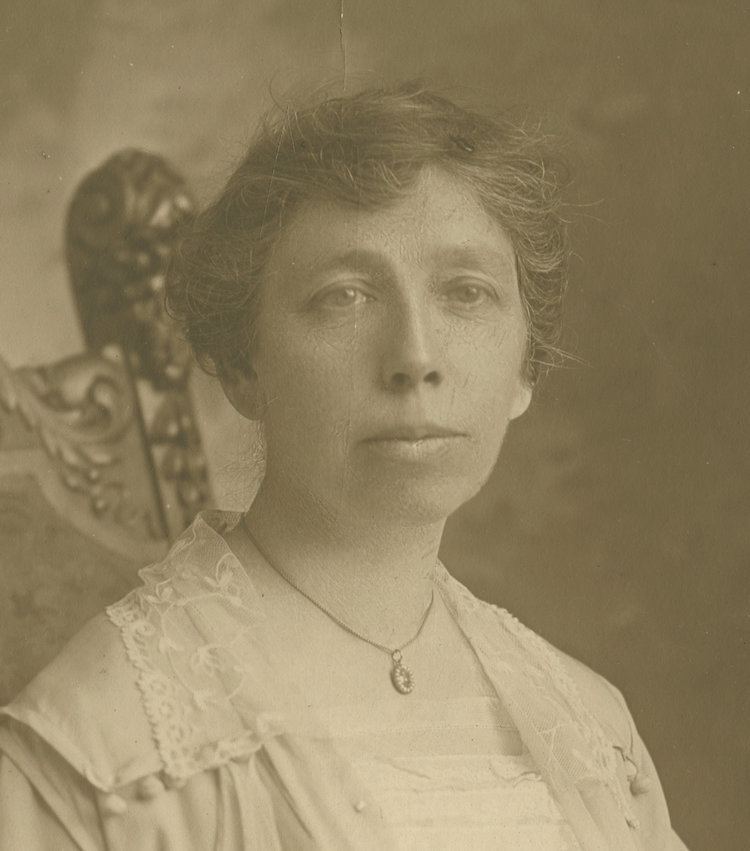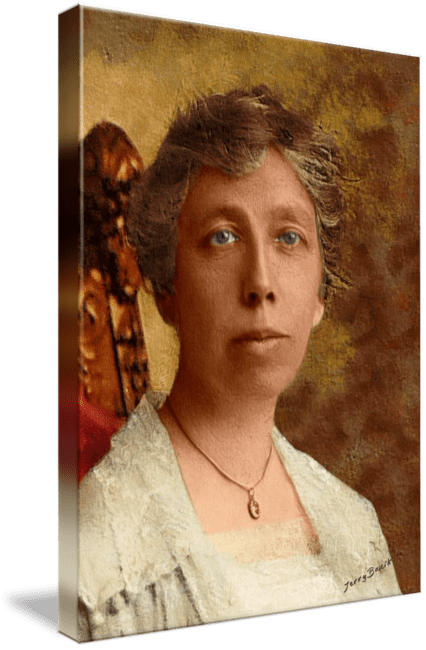Nationality American Name Christine Ladd-Franklin | Role Psychologist | |
 | ||
Influences Charles Sanders PeirceJames Joseph Sylvester Books Colour and Colour Theories Influenced by | ||
Christine Ladd-Franklin (December 1, 1847 – March 5, 1930) was an American psychologist, logician, and mathematician.
Contents
- Psyc 3901 christine ladd franklin
- Early life and education
- Early career
- Graduate education
- Major contributions and achievements
- Ladd Franklins theory of color vision
- Stages of color vision
- Mathematics and logic
- Professional involvement
- Published works
- References

Psyc 3901 christine ladd franklin
Early life and education

Christine Ladd, sometimes known by her nickname "Kitty," was born on December 1, 1847 in Windsor, Connecticut to Eliphalet Ladd, a merchant, and Augusta Niles Ladd. During her early childhood, she lived with her parents and younger brother Henry (born 1850) in New York City. In 1853 the family moved back to Windsor, Connecticut where her sister Jane Augusta Ladd McCordia was born the following year. Throughout her childhood, Ladd's mother and aunt, Juliet Niles, often chose to bring the young Christine with them to numerous women's rights lectures and suffrage meetings because both were incredibly passionate supporters of women's rights. Augusta Ladd believed that women had every right to be in the same positions that were held by men and "belonged every place where a man should be." Ladd's mother wanted to instill these same beliefs into her impressionable daughter so that she could grow up to be successful in later life and not be held back by societal expectations.
Following the death of her mother in spring 1860 to pneumonia, Ladd went to live with her paternal grandmother in Portsmouth, New Hampshire where she attended school. Ladd's father remarried in 1862 and produced her half-sister Katherine (born 1862) and half-brother George (born 1867). Ladd was a precocious child who sought to find “a mean to continue her education beyond secondary school.”. Ladd's wish was granted when her father enrolled her in a two-year program at a coeducational Welshing academy in Wilbraham, Massachusetts; she took the same courses that prepared boys in furthering their education to colleges such as Harvard.
In 1865 Christine Ladd graduated as valedictorian from Welshing Academy and made the decision to pursue further education at Vassar College. This decision would not be supported by her family due to the fact that Ladd's father and grandmother believed college was unnecessary for a woman and by choosing to go to Vassar, Ladd would end up being too old to take a husband. The family saw college as a hindrance since women in the nineteenth century were expected to wed young, produce children, and stay at home to raise a family. Ladd was ultimately able to argue that she was "not attractive enough to find a husband and that there was a shortage of men as a result of the Civil War." This argument was eventually effective in convincing her family that college was the best option for her.
In the fall of 1866 Ladd enrolled in Vassar College with a loan provided by her late mother's sister. She only studied at Vassar until the end of the spring term due to financial issues. During the time that she was not attending college Ladd worked as a public school teacher until her aunt's aid allowed her to reenter Vassar and graduate in 1869. While attending Vassar, Ladd began working under the mentorship of astronomy professor, Maria Mitchell, who was famous for having been "the first woman to discover a new comet, using a telescope, in 1847" Mitchell was also a suffragette and strove to inspire women to gain more self-confidence in order to succeed in male-dominated fields during the time period. Under the guidance of Mitchell, Ladd was able to blossom and quickly developed a love for the fields of physics and mathematics. Since women in the nineteenth century were not allowed in the male dominated physics laboratories, Ladd was unable to pursue her first love of physics and chose instead to study mathematics. Later in her life, Ladd would eventually reflect back on her decision and say, "had it not been for the impossibility, in those days, in the case of women, of obtaining access to laboratory facilities" she would have eagerly gone on to study physics.
Early career
After graduating, Ladd taught science and mathematics at secondary level in Washington, Pennsylvania. During this time, Ladd contributed seventy-seven mathematical problems and solutions to the Educational Times of London. She also published six items in The Analyst: A Journal of Pure and Applied Mathematics and three in the American Journal of Mathematics.
Graduate education
In 1878, Ladd was accepted into Johns Hopkins University with the help of James J. Sylvester, an English mathematician who remembered some of Ladd's earlier works in London's Educational Times. Ladd's application for the University fellowship was signed "C. Ladd", and Hopkins offered the fellowship to her without realizing she was a woman. When they did realize this, the board moved to revoke the offer, but Sylvester insisted that Ladd should be his student, and so she was. She held a fellowship at Hopkins for three years, but the trustees did not allow her name to be printed in circulars with those of other fellows, for fear of setting a precedent. Furthermore, dissension over her continued presence forced one of the original trustees to resign.
Since Hopkins did not approve of coeducation, Ladd was initially allowed only in classes taught by Sylvester. But after displaying exceptional work in Sylvester's courses, Ladd was allowed to take courses with different professors. Even though she was awarded a stipend, she was known as a fellow student. During 1879–1880, Ladd took classes taught by Charles Sanders Peirce, who has been called the first American experimental psychologist. She wrote a dissertation "On the Algebra of Logic" with Peirce as the thesis advisor. The dissertation was published in Studies in Logic (Peirce, ed.) in 1883. Due to her studies with Peirce, Ladd became the first American woman to be involved in psychology, mathematics and logic. Since women were not allowed to graduate at Hopkins, Ladd was refused a Ph.D. in Mathematics and Logic, although she was the first woman to complete all the requirements for a PhD at Hopkins. However, Hopkins officially granted her a Ph.D. in 1927 (44 years after she had earned it) at the age of seventy-eight.
In 1884 Cristine attended Kelvin's master class. She married another attendee in class, Fabian Franklin, Ph.D. (mathematics), hence she became Christine Ladd-Franklin. Ladd-Franklin had two children, one of whom died in infancy. The other, Margaret Ladd-Franklin, became a prominent member in the women's suffrage movement.
Major contributions and achievements
After leaving Hopkins, Ladd-Franklin worked with German psychologist G. E. Müller, where she carried out experimental work in vision. Ladd-Franklin was also able to work in the laboratory of Hermann von Helmholtz, where she attended his lectures on theory of color vision. After attending these lectures, Ladd-Franklin developed her own theory of color vision. In 1929 she published Color and Color Theories.
Ladd-Franklin's theory of color vision
One of the major contributions that Ladd-Franklin made to psychology was her theory of color vision, which was based on evolution. Ladd-Franklin noted that: "some animals are color blind and assumed that achromatic vision appeared first in evolution and color vision came later." She assumed further that the human eye carries vestiges of its earlier evolutionary development. She observed that the most highly evolved part of the eye is the fovea, where, at least in daylight, visual acuity and color sensitivity are greatest. Ladd-Franklin assumed that peripheral vision (provided by the rods of the retina) was more primitive than foveal vision (provided by the cones of the retina) because night vision and movement detection are crucial for survival."
Stages of color vision
Ladd-Franklin concluded that color vision evolved in three stages: achromatic vision (black and white), blue-yellow sensitivity and red-green sensitivity. Since red-green sensitivity was the last to evolve it explains why many people suffer from red-green color blindness. The next one that affects a small population is blue-yellow color blindness. Since achromatic vision was the first to evolve it explains why the majority of the population are not affected by black-white color blindness.
Mathematics and logic
Ladd-Franklin was the first woman to have a published paper in the Analyst. She was also the first woman to receive a Ph.D. in mathematics and logic. The majority of her publications were based on visual processes and logic. Her views on logic influenced Charles S. Peirce's logic and she was highly praised by Prior.
Professional involvement
Ladd-Franklin was among the first women to be inducted into the American Psychological Association in December 1893. From 1894-1925, Ladd-Franklin presented ten papers at APA meetings. She was also one of the first female members of the Optical Society of America (OSA) in 1919. During the OSA meetings she presented six papers and two exhibits. She was also a prominent member of the women's rights movement. Ladd-Franklin was included in the Who's Who in America during 1901-1902 and 1914-1915. Ladd-Franklin remained a member of APA and OSA until her death on March 5, 1930 in New York, New York.
In 1948, Bertrand Russell wrote: "I once received a letter from an eminent logician, Mrs. Christine Ladd-Franklin, saying that she was a solipsist, and was surprised that there were no others. Coming from a logician and a solipsist, her surprise surprised me."
